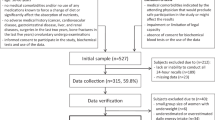Abstract
Objective:
The aim of this study was to verify if six months of isoflavone supplementation could increase fat-free mass (FFM) and muscle mass index (MMI=appendicular FFM/height2) in obese–sarcopenic postmenopausal women.
Design:
Double-blind randomized study.
Subject:
Eighteen sarcopenic–obese women completed the study (12 on isoflavones and six on placebo). Body composition was measured by dual-energy X-ray absorptiometry. Subjects ingested 70 mg of isoflavones per day (44 mg of diadzein, 16 mg glycitein and 10 mg genestein) or a placebo for 24 weeks.
Results:
The isoflavone group increased significantly appendicular (P=0.034), leg (P=0.016) FFM and MMI (P=0.037), but not the placebo group.
Conclusion:
Six months of isoflavone supplementation increased FFM and MMI in obese–sarcopenic postmenopausal women.
This is a preview of subscription content, access via your institution
Access options
Subscribe to this journal
Receive 12 print issues and online access
$259.00 per year
only $21.58 per issue
Buy this article
- Purchase on Springer Link
- Instant access to full article PDF
Prices may be subject to local taxes which are calculated during checkout
Similar content being viewed by others
References
Aubertin-Leheudre M, Audet M, Goulet ED, Dionne IJ (2005). HRT provides no additional beneficial effect on sarcopenia in physically active postmenopausal women: a cross-sectional, observational study. Maturitas 51, 140–145.
Baumgartner RN, Wayne SJ, Waters DL, Janssen I, Gallagher D, Morley JE (2004). Sarcopenic obesity predicts instrumental activities of daily living disability in the elderly. Obes Res 12, 1995–2004.
Baumgartner RN, Koehler KM, Gallagher D, Romero L, Heymsfield SB, Ross RR et al. (1998). Epidemiology of sarcopenia among the elderly in New Mexico. Am J Epidemiol 147, 755–763.
Beaufrere B, Morio B (2000). Fat and protein redistribution with aging: metabolic considerations. Eur J Clin Nutr 54 (Suppl 3), S48–S53.
Crisafulli A, Altavilla D, Marini H, Bitto A, Cucinotta D, Frisina N et al. (2005). Effects of the phytoestrogen genistein on cardiovascular risk factors in postmenopausal women. Menopause 12, 186–192.
Dragan I, Stroescu V, Stoian I, Georgescu E, Baloescu R (1992). Studies regarding the efficiency of Supro isolated soy protein in Olympic athletes. Rev Roum Physiol 29, 63–70.
Fox AA, Thompson JL, Butterfield GE, Gylfadottir U, Moynihan S, Spiller G (1996). Effects of diet and exercise on common cardiovascular disease risk factors in moderately obese older women. Am J Clin Nutr 63, 225–233.
Greeves JP, Cable NT, Reilly T, Kingsland C (1999). Changes in muscle strength in women following the menopause: a longitudinal assessment of the efficacy of hormone replacement therapy. Clin Sci (Lond) 97, 79–84.
Haarbo J, Marslew U, Gotfredsen A, Christiansen C (1991). Postmenopausal hormone replacement therapy prevents central distribution of body fat after menopause. Metabolism 40, 1323–1326.
Hermansen K, Sondergaard M, Hoie L, Carstensen M, Brock B (2001). Beneficial effects of a soy-based dietary supplement on lipid levels and cardiovascular risk markers in type 2 diabetic subjects. Diabetes Care 24, 228–233.
Hsu CS, Shen WW, Hsueh YM, Yeh SL (2001). Soy isoflavone supplementation in postmenopausal women. Effects on plasma lipids, antioxidant enzyme activities and bone density. J Reprod Med 46, 221–226.
Janssen I, Heymsfield SB, Ross R (2002). Low relative skeletal muscle mass (sarcopenia) in older persons is associated with functional impairment and physical disability. J Am Geriatr Soc 50, 889–896.
Lemoine S, Granier P, Tiffoche C, Rannou-Bekono F, Thieulant ML, Delamarche P (2003). Estrogen receptor alpha mRNA in human skeletal muscles. Med Sci Sports Exerc 35, 439–443.
Moeller LE, Peterson CT, Hanson KB, Dent SB, Lewis DS, King DS et al. (2003). Isoflavone-rich soy protein prevents loss of hip lean mass but does not prevent the shift in regional fat distribution in perimenopausal women. Menopause 10, 322–331.
Rossouw JE, Anderson GL, Prentice RL, LaCroix AZ, Kooperberg C, Stefanick ML et al. (2002). Risks and benefits of estrogen plus progestin in healthy postmenopausal women: principal results from the Women's Health Initiative randomized controlled trial. JAMA 288, 321–333.
Skelton DA, Phillips SK, Bruce SA, Naylor CH, Woledge RC (1999). Hormone replacement therapy increases isometric muscle strength of adductor pollicis in post-menopausal women. Clin Sci (Lond) 96, 357–364.
Sowers MR, Crutchfield M, Richards K, Wilkin MK, Furniss A, Jannausch M et al. (2005). Sarcopenia is related to physical functioning and leg strength in middle-aged women. J Gerontol A Biol Sci Med Sci 60, 486–490.
Tanko LB, Movsesyan L, Mouritzen U, Christiansen C, Svendsen OL (2002). Appendicular lean tissue mass and the prevalence of sarcopenia among healthy women. Metabolism 51, 69–74.
van der Schouw YT, Kreijkamp-Kaspers S, Peeters PH, Keinan-Boker L, Rimm EB, Grobbee DE (2005). Prospective study on usual dietary phytoestrogen intake and cardiovascular disease risk in Western women. Circulation 111, 465–471.
Walker HA, Dean TS, Sanders TA, Jackson G, Ritter JM, Chowienczyk PJ (2001). The phytoestrogen genistein produces acute nitric oxide-dependent dilation of human forearm vasculature with similar potency to 17beta-estradiol. Circulation 103, 258–262.
Wu J, Wang X, Chiba H, Higuchi M, Nakatani T, Ezaki O et al. (2004). Combined intervention of soy isoflavone and moderate exercise prevents body fat elevation and bone loss in ovariectomized mice. Metabolism 53, 942–948.
Author information
Authors and Affiliations
Corresponding author
Rights and permissions
About this article
Cite this article
Aubertin-Leheudre, M., Lord, C., Khalil, A. et al. Six months of isoflavone supplement increases fat-free mass in obese–sarcopenic postmenopausal women: a randomized double-blind controlled trial. Eur J Clin Nutr 61, 1442–1444 (2007). https://doi.org/10.1038/sj.ejcn.1602695
Received:
Revised:
Accepted:
Published:
Issue Date:
DOI: https://doi.org/10.1038/sj.ejcn.1602695
Keywords
This article is cited by
-
Dietary phytochemicals as a promising nutritional strategy for sarcopenia: a systematic review and meta-analysis of randomized controlled trials
Applied Biological Chemistry (2021)
-
Treatment of body composition changes in obese and overweight older adults: insight into the phenotype of sarcopenic obesity
Endocrine (2014)
-
The new metabolic treatments for sarcopenia
Aging Clinical and Experimental Research (2013)
-
ISSN exercise & sport nutrition review: research & recommendations
Journal of the International Society of Sports Nutrition (2010)



